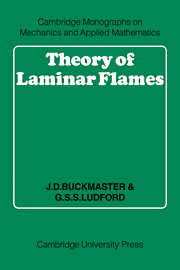Book contents
- Frontmatter
- Contents
- Preface
- 1 Governing equations of combustion
- 2 The premixed plane flame
- 3 Perturbations: SVFs and NEFs
- 4 Steady burning of a linear condensate
- 5 Unsteady burning of a linear condensate
- 6 Spherical diffusion flames
- 7 Cylindrical and spherical premixed flames
- 8 Multidimensional theory of premixed flames
- 9 Burners
- 10 Effects of shear and strain
- 11 Stability
- 12 Ignition and explosion
- Text references
- Further references
- Citation Index
- Subject Index
12 - Ignition and explosion
Published online by Cambridge University Press: 05 May 2010
- Frontmatter
- Contents
- Preface
- 1 Governing equations of combustion
- 2 The premixed plane flame
- 3 Perturbations: SVFs and NEFs
- 4 Steady burning of a linear condensate
- 5 Unsteady burning of a linear condensate
- 6 Spherical diffusion flames
- 7 Cylindrical and spherical premixed flames
- 8 Multidimensional theory of premixed flames
- 9 Burners
- 10 Effects of shear and strain
- 11 Stability
- 12 Ignition and explosion
- Text references
- Further references
- Citation Index
- Subject Index
Summary
Synopsis
Ignition has been discussed in three contexts: burning of a linear condensate (Chapter 4), spherical diffusion flames (Chapter 6), and spherical premixed flames (Chapter 7). Based upon the S-shaped response curves determined by steady-state analyses it is argued that the burning rate will jump from a weak, almost extinguished, level to a vigorous one as the pressure (and, hence, the Damköhler number) is increased through some critical value (corresponding to the lower bend of the S). The occurrence of an intrinsically unsteady phenomenon, appropriately called ignition, is thereby inferred from results inherent in the steady state.
Such analyses have a fairly long history in combustion investigations, the simplest example being the thermal theory of spontaneous combustion identified with the name of its originator, Frank-Kamenetskii (1969). Section 2 presents a mathematical version of that theory, which shows an early appreciation of activation-energy asymptotics (though not in the formal sense of this monograph).
Even though steady-state analyses are undoubtedly useful, descriptions of the unsteady state are also needed; providing them is the main goal of this chapter. The three contexts already considered are too complicated for our purposes; we concentrate instead on a simpler problem containing the essential feature of ignition: the evolution of a deflagration wave from an unburnt state.
Consider a thermally insulated enclosure containing a mixture at sufficiently low temperature for the reaction to be very weak. Since the heat released cannot escape, the temperature must rise, albeit very slowly.
- Type
- Chapter
- Information
- Theory of Laminar Flames , pp. 221 - 247Publisher: Cambridge University PressPrint publication year: 1982



